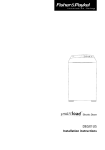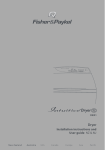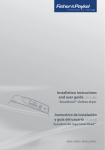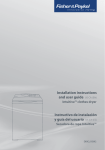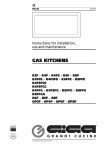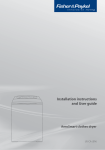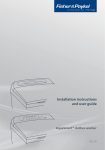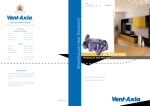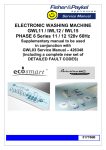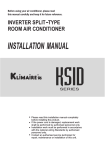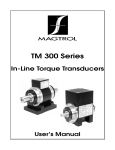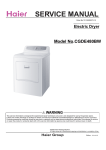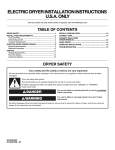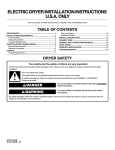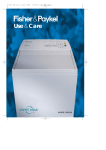Download Fisher & Paykel Smartload DGGX1US User's Manual
Transcript
Gas Dryer
DGGX1US
Installation instructions
WARNING
For your safety the information in this manual must be followed to minimize the risk
of death, personal injury, fire, explosion, or property damage.
Do not store or use gasoline or other flammable vapors and liquids near this or any
other appliance.
What to do if you smell gas
Do not try to light or start any appliance.
Do not touch any electrical switch; do not use any telephone in your building.
Clear the room, building or area of all occupants.
Immediately call your gas supplier from a neighbor’s telephone. Follow the gas supplier’s
instructions.
If you cannot reach your gas supplier, call the fire department.
A qualified installer, service agency or the gas supplier must perform installation
and service.
The Governor of California is required to publish a list of substances known to the
state of California to cause cancer or reproductive harm and requires business to
warn customers of potential exposures to such substances.
Gas appliances contain or produce substances, which can cause death, or serious
illness and which are known to the State of California to cause cancer, birth defects,
or other reproductive harm. To reduce the risk from substances in fuel or from
fuel combustion, make sure this appliance is installed, operated, and maintained
according to the manufacturers instructions.
2
Important safety instructions
WARNING
To reduce the risk of fire, electric shock, or injury to persons when using your appliance, follow
basic precautions, including the following:
1. Read all instructions before using the appliance.
2. Installation and service must be performed by a qualified installer, service agency or the gas
supplier.
3. Make sure the power cord is located so that it will not be stepped on, tripped over or
otherwise subject to stress or damage.
4. Pressing the POWER button to turn the dryer off, does NOT disconnect the dryer from the
power supply, even though the dryer lights are out.
5. Do not operate this dryer if it is damaged, malfunctioning, partially disassembled or has
missing or broken parts, including a damaged cord or plug.
6. Do not dry articles that have been previously cleaned in, washed in, soaked in, or spotted
with, gasoline, dry-cleaning solvents, other flammable or explosive substances as they give off
vapors that could ignite or explode.
7. Close supervision is necessary if this dryer is used by or near children. Do not allow children to
play inside, around or with this dryer or any other appliance.
8. Before the appliance is removed from service or discarded, remove the lid and drum door to
the drying compartment.
9. Do not reach into the appliance if the drum is moving.
10. Do not install or store this appliance where it is exposed to water and or the weather.
11. Do not tamper with the controls or the lid lock.
12. Do not repair or replace any part of the appliance or attempt any servicing unless specifically
recommended in the user-maintenance instructions or in published user-repair instructions
that you understand and have the skills to carry out.
13. Unless specifically recommended by their manufacturer, do not use fabric softeners or similar
products in a tumble dryer.
14. Do not use heat to dry articles containing foam rubber or similar textured rubber-like materials.
15. Check to see if the lint bucket needs emptying. Empty before the lint reaches the top of the
transparent section (usually once a week).
16. Keep area around the exhaust opening and adjacent surrounding areas free from the
accumulation of lint, dust, and dirt.
17. Have the interior of the appliance and exhaust duct cleaned periodically by qualified service
personnel.
18. Do not place items exposed to cooking oils or other vegetable oils in your dryer. Items
contaminated with cooking and other vegetable oils may contribute to a chemical reaction
that could cause a load to catch fire.
SAVE THESE INSTRUCTIONS
3
Read this before you start installing your dryer
This is the safety alert symbol. This symbol alerts you to hazards that can kill or hurt
you and others. The safety alert symbol and the word DANGER or WARNING will
precede all safety messages. These words mean:
DANGER
You can be killed or seriously injured if you don’t
immediately follow instructions.
WARNING
You can be killed or seriously injured if you don’t follow
instructions.
All safety messages will identify the hazard, tell you how to reduce the chance of injury, and tell
you what can happen if the instructions are not followed.
Check to make sure you have all the tools and parts necessary to correctly install this appliance.
Tools required
1⁄4’’ nut driver or socket wrench
Phillips screwdriver
Flat-blade screwdriver
Adjustable wrench that opens to 1’’ or 1’’ hex-head socket wrench (for adjusting the feet)
Adjustable wrench 8” or 10” (20cm or 25cm) for gas connections
Level
Pipe joint compound (pipe dope or tape) for gas pipe connections that is resistant to LP Propane,
Butane and Natural Gas
Caulking gun and compound (for installing new exhaust vent)
Gloves
Safety glasses
Knife
Duct tape
Parts supplied
2 feet inserts
A power supply cord is supplied already connected to the gas dryer
Check to make sure all parts have been supplied.
Accessories
Natural Gas to LP Conversion Kit Part No 395489
LP to Natural Gas Conversion Kit Part No 395490
Mobile Home Installation Kit Part No 395488
Drying Rack Part No 395332P
Parts needed
Check with local codes and read electrical, gas and venting requirements before purchasing parts.
4
To the installer
The correct installation of the dryer is your responsibility.
Be sure you read the following instructions carefully before you start to install the dryer. These
instructions should be left with the home owner for future reference.
It is your responsibility to:
Observe all governing codes and ordinances.
Check code requirements. Some codes limit or do not permit installation of clothes dryers in
garages, closets, mobile homes or sleeping quarters. Contact your local building inspector.
Adhere to these installation instructions.
Allow for spacing requirements with side by side installations (refer page 6).
Make sure you have all items necessary for correct installation.
Properly install the dryer.
Contact a qualified installer to ensure that the electrical and gas installation meets all national
and local codes and ordinances.
Location requirements
WARNING
Explosion Hazard
Keep flammable materials and vapours, such as gasoline,
away from the dryer.
Place dryer at least 18 inches (46 cm) above the floor for a
garage installation.
Failure to do so can result in death, explosion, fire, or burns.
The dryer must be installed or stored in an area which is not exposed to water or weather.
It is extremely important that the dryer is installed in a well ventilated location. This dryer must
exhaust air outdoors. Do not install the dryer in any room or closet which does not permit the
free flow of replacement air.
Before installing the dryer ensure that there is sufficient height to fully open the lid. Allow
sufficient room behind the dryer for the exhaust. The air intake is at the rear of the dryer. Ensure
that there is a sufficient air passage on each side of the dryer for intake air.
5
The area in which the dryer is located must be kept clear and free from combustible materials,
gasoline and other flammable vapours and liquids. A dryer produces combustible lint so the area
around the dryer must be cleaned regularly to keep it free of lint.
This dryer can only be vented from the rear and must be exhausted to the outdoors.
Alcove or closet installation
WARNING
When installing a dryer in a closet/alcove it must be
exhausted to the outdoors. No other fuel burning
appliance can be installed in the same closet or alcove.
The top opening area in the door must be a minimum of 48 square inches (310cm2) and the
bottom opening area must have a minimum of 24 square inches (155cm2). These openings must
never be obstructed (a louvred door with the minimum air opening is acceptable). Minimum
installation clearances are required but more clearance is recommended.
min 56"
(1372 – 1422mm)
1" (25mm)
1" (25mm)
1" (25mm)
min 2" (50mm) min 3" (76mm)
48 sq" (310cm2)
total ventation area
72 sq" (465cm2)
6
24 sq" (155cm2)
Dimensions
Lid clearance
�� ���� � �� �����
���� � ������
�� ���� � �� �����
����� � �������
��� ����� � �������
Check that there is enough clearance for the lid to fully open.
�� ����� �������
��� �������
Exhaust outlet location
4 3/ 8"
(111mm)
Exhaust outlet
13 7/8" (352mm)
13 1/8" (333mm)
7
Mobile home installation
The installation of the dryer in a mobile home must conform to the Manufactured Home
Construction and Safety Standard Title 24 CFR, Part 32-80 {formerly the Federal Standard for
Mobile Home Construction and Safety, Title 24 HUD (Part 280), 1975} for the United States.
When installing a dryer in a mobile home, provisions for anchoring the dryer to the floor must
be made.
A Mobile Home Installation kit is available with instructions (see Accessories page 4). Locate
in an area that has adequate make up air (a minimum of 72 square inches of unobstructed
opening is required).
Mobile home installations must be exhausted to the outdoors with the exhaust duct
termination securely fastened to the mobile home structure, using materials that will not
support combustion.
The exhaust duct must not terminate beneath the mobile home. See the section on exhausting
for more information.
��� ����� ���� ��
��������� �������
�������
����
��� ������� ���� ���� �� ��������
�������� �� � ���������������
������� �� ��� ������ ����
��������� ��� ���� ��� ���������
������� ��� ������ �����
�����
�������� ����
��������
8
Exhausting
The dryer must be exhausted to the outdoors. This will prevent the build up of lint and moisture
in the room in which it is located and reduce the risk of fire.
WARNING
Fire Hazard
The dryer must be vented to the outdoors.
Use rigid or thick wall flexible metal exhaust duct.
Do not use a plastic exhaust duct.
Do not use a metal foil exhaust duct.
Failure to follow these instructions can result in death or fire.
This appliance must always be vented to the outdoors.
Exhaust ducting products can be purchased from your local Appliance store or Hardware store.
Plastic or metal foil flexible duct can kink, sag, be punctured, reduce airflow, extend drying times
and affect dryer operation.
A minimum of 4 inch (100mm) thick wall flexible metal or rigid galvanised metal duct must be
used. Using ducts larger than 4 inches (100mm) diameter may result in more lint accumulating.
Using straight rigid metal ducting will minimise lint accumulation. Thick wall flexible metal
ducting may be used but care must be exercised to avoid sharp bends which may squash the
duct & cause blockages. Do not use plastic ducting or thin wall flexible metal ducting.
Use duct tape to secure joints. Do not use screws as they collect lint.
Keep ducting as short and straight as possible. Do not exceed the maximum exhaust duct
lengths stated later in these installation instructions.
Do not exhaust the dryer into a chimney or gas vent, a wall, a ceiling or any concealed space in a
building. Do not exhaust the dryer under a house or mobile home or a porch, or into a window
well or other area that will accumulate lint.
The exhaust duct should end with an exhaust hood with a swing
out damper to prevent back drafts and entry of wild life. Never use
exhaust hoods with a magnetic damper. The hood should have
at least 12 inches (305mm) clearance between the bottom of the
hood and the ground or other obstruction. The hood opening
should point down. Never install a screen over the exhaust outlet.
12" (305mm)
9
To reduce condensation, insulate any ducting which passes through unheated areas.
Slope the duct gently downwards to the hood, to drain condensation and reduce lint build up.
Avoid sag or loops in the duct as they may collect and store water and accumulate lint.
Before using an existing exhaust duct system for a dryer ensure that:
No plastic or other potentially combustible duct or flexible metal foil ducting has been used.
The duct is not pierced, kinked or crushed.
The duct does not exceed the maximum recommended length for the new dryer.
The exhaust hood damper opens and closes freely and with sufficient movement.
Static pressure in the exhaust ducting does not exceed 1 inch (250Pa), or is not less than 0 inches
of water column (ie. negative pressure), when measured with a manometer in the first 6 inches
of the duct, with the dryer running on Air Dry (no heat) setting.
The exhaust duct system meets all relevant local, state and national codes.
All ducting should be inspected and cleaned at least once a year to remove accumulated lint.
Frequently check that the damper on the exhaust hood moves sufficiently and opens and
shuts freely.
Mobile home installations
A Mobile Home Installation Kit is available (see Accessories page 4 and notes page 8).
Determine vent duct length
This dryer can only be vented from the rear and must be exhausted to the outdoors.
Different types of vent arrangements are shown below.
10
Choose a route that will provide the straightest and most direct path outdoors. Plan the
installation to use the fewest number of elbows and turns.
When using elbows (rigid duct) or making turns (thick wall flexible metal duct), allow as much
room as possible. With thick wall flexible metal duct bend duct gradually to avoid kinking and
avoid 90˚ turns.
recommended
acceptable
Maximum length of exhaust duct
The maximum length of the exhaust duct system depends upon:
The type of ducts (rigid or thick walled flexible metal).
The number of elbows or bends used.
1. Refer to the exhaust duct length chart that matches your hood type for the maximum duct
lengths you can use. Do not use duct runs longer than specified in the exhaust duct length
charts (refer to next page).
Exhaust duct systems longer than specified will:
Accumulate lint creating a potential fire hazard.
Shorten the life of the dryer.
Reduce performance, resulting in longer drying times and an increased energy usage.
2. Determine the number of elbows/bends you will need.
3. In the column listing the type of metal duct you are using (rigid or thick wall flexible metal),
find the maximum length of metal duct on the same line as the number of elbows/bends to
be used (refer to next page).
11
Preferred 4” Hoods
When you have a 4” (10cm) Hood
Maximum length of 4” diameter metal duct.
Number of 90˚
elbows/bends
Thick Wall Flexible Metal
(fully extended)
Rigid
0
64ft
19.5m
36ft
10.9m
1
54ft
16.5m
31ft
9.4m
2
44ft
13.4m
27ft
8.2m
3
35ft
10.6m
25ft
7.6m
4
27ft
8.2m
23ft
7.0m
Acceptable 2 1⁄2”Hood
When you have a 2 1⁄2” (6cm) Hood
Maximum length of 4” diameter metal duct.
Number of 90˚
elbows/bends
Rigid
Thick Wall Flexible Metal
(fully extended)
0
58ft
17.6m
28ft
8.5m
1
48ft
14.6m
23ft
7.0m
2
38ft
11.5m
19ft
5.7m
3
29ft
8.8m
17ft
5.1m
4
21ft
6.4m
15ft
4.5m
For exhaust systems not covered by the exhaust duct length charts (such as multiple unit
hook-ups, plenums, and power-assist fans), call our Customer Care Center: TOLL FREE 888 9FNP USA
(888 936 7872).
12
Alternative installation for close clearances
Venting systems come in many varieties. Select the type best for your installation.
A close-clearance installation is shown.
swivel collar
wall connection
sections separate,
fittings can face
same or opposite
swivel collar
Extra long
band–clamp
for dryer
connection
telescoping
sections
beveled edges
allow corner
installations
The maximum length using a 2” x 6” (5cm x 15cm) rectangular duct with two elbows and a
2 1⁄2”(6.3cm) exhaust hood is 8ft (2.4m).
Refer to the venting system kit manufacturers instructions.
13
Exhaust venting
WARNING
Fire Hazard
Use heavy metal exhaust duct.
Do not use a plastic exhaust duct.
Do not use thin metal foil exhaust duct.
Failure to do so can result in death or fire.
1. Read the exhaust section (page 9–13) before installing the exhaust system to determine the
maximum allowable exhaust duct length.
Do not use sheet metal screws when assembling ducting. Always use suitable duct tape.
Never use plastic or thin metal foil flexible exhaust material.
2. The exhaust outlet is located close to the center of the rear of the dryer. Make sure you
join the exhaust duct to the dryer with duct tape only. This will prevent lint and dust from
escaping from the dryer and exhaust system.
4 3/ 8"
(111mm)
Exhaust outlet
13 7/8" (352mm)
13 1/8" (333mm)
3. The exhaust vent can be routed up, down, left, right or straight out the back of the dryer.
Refer to diagram.
14
Installation
Parts and literature are packaged inside the dryer drum.
WARNING
Excess Weight Hazard
Use two or more people to move and install the dryer.
Failure to do so can result in back or other injury.
Only remove the packaging at the customer’s premises.
This will ensure the appliance arrives in pristine condition and reduces the risk of damage when
transporting to the customer’s home.
Unpacking
Make sure dryer is in a suitable location for installation.
Consider installing the dryer before the washing machine in a side by side installation, this will
allow better access to electrical and exhaust connections.
Remove packaging
1.
1. Remove straps.
4.
2.
3.
2. Unfold the bottom
flaps on the carton.
3. Unfold the top flaps
on the carton,
remove top packer.
6.
5.
Tilt
Walk
off
Slide out
4. Remove the carton
by lifting it off the
product (do not cut
the carton off ).
5. Remove the
basepacker by tilting
the product back and
walking the product.
6. Remove the drum
packer and the tape
from the lint collector
bucket in the drum.
15
Fitting the front feet
Note: Dryer is usually supplied with feet fitted and protruding the correct distance.
1. Tilt the dryer back using a hand trolley and making sure the trolley and dryer are secure.
2. Fit a rubber insert to each plastic foot as shown.
3. Screw the feet into the foot retainers on the left hand and right hand sides as shown.
4. Screw both feet in so they protrude 1⁄2” (12mm) below the bottom of the wall on the foot
retainers.
16
Electrical requirements
WARNING
Electrical Shock Hazard
Plug into a grounded 3-prong outlet.
Do not remove ground prong.
Do not use an adaptor.
Do not use an extension lead.
Failure to follow these instructions can result in death, fire,
or electrical shock.
Grounding instructions
This appliance must be grounded. In the event of malfunction or breakdown, grounding will
reduce the risk of electric shock by providing a path of least resistance for electric current. This
dryer is manufactured with a cabinet grounding conductor and plug. The plug must be plugged
into the correct type of outlet which has been properly installed and grounded in accordance
with local codes and ordinances.
WARNING
Electrical Shock Hazard
Check with a qualified electrician or serviceman if you are
in doubt as to whether the appliance is properly grounded.
Do not modify the plug if it will not fit the outlet.
Have the proper outlet installed by a qualified electrician.
Failure to do so can result in death, fire, or electrical shock.
17
Gas requirements
The installation must conform with Local Codes, or in the absence of Local Codes, to the National
Fuel Gas Code ANSI/Z223.1, Latest Revision (for the United States).
WARNING
Explosion Hazard
Use a new AGA or CSA approved gas supply line.
Install a shut-off valve.
Securely tighten all gas connections.
If connecting to LP Gas, have a qualified person make sure
gas pressure does not exceed 13” (33 cm) water column.
Examples of a qualified person include:
Licensed heating personnel,
Authorised gas company personnel and authorised service
personnel.
Failure to follow these instructions can result in death,
explosion, or fire.
Gas type
Your dryer must have the correct burner for the type of gas in your home. Burner information is
located on the rating plate located on the back splash. If this information does not agree with
the type of gas available in your home, contact your local Fisher & Paykel supplier or service
center.
Natural Gas
This dryer is supplied ready for use with Natural Gas.
It is design certified by UL International for LP (Propane or Butane) Gases with the appropriate
conversion.
LP Gas conversion
If the dryer is to be operated on LP (Liquid Propane or Butane) Gas, the dryer must be converted.
To do so, use only the approved Fisher & Paykel conversion kit listed in Accessories on page 4.
Do not use with a different gas without consulting the serving gas supplier.
The dryer must be converted for safe and proper performance by qualified service or installation
personel.
Conversion kits for Natural and LP Gas are available from your local Fisher & Paykel Dealer (see
Accessories page 4). If other conversions are required, check with your local gas utility for specific
information concerning conversion requirements.
18
Connecting gas to your dryer
Use compound or thread tape appropriate to the gas type that is to be used (Natural or LP Gas),
on the male threads of all non-flared connections.
Never use an open flame to test for gas leaks.
This dryer will operate satisfactorily up to altitudes of 6500ft (2000m) above sea level at the
BTU rating indicated on the model/serial plate. Burner input adjustments may be required if
operating above this elevation.
The dryer must be isolated from the gas supply piping system by closing the supply shut-off
valve during any pressure testing of the gas supply piping system.
Gas ignition
This dryer has an automatic ignition system to ignite the burner. There is no pilot flame burning
in this dryer.
Connecting to the gas supply
1. The gas supply line should be 1⁄2 inch.
2. A shut-off valve must be installed on the gas supply line within 6ft (1.8m) of the dryer.
3. An ⁄ inch NPT plugged tapping must be installed to allow the gas inlet pressure to be
checked.
/ ” NPT plugged tapping
1 8
Gas shut-off valve
/ ” NPT gas supply line
1 2
19
Connecting to the dryer
4. To connect the dryer to the gas supply, a number of options and types of connections can be
used, such as rigid piping or tubing, or if local codes permit, new flexible tubing.
5. If flexible tubing is used, an elbow should be installed on the pipe at the back of the dryer for
the flexible tube to be connected to. This will minimise damage to the tube when the dryer
is moved back. Use a flexible tubing connection kit that has designed for use on a clothes
dryer. This kit should have the unions necessary to join to the ends of the tubing. Be sure to
follow all instructions supplied with the kit.
6. Copper tubing should not be used for Natural Gas and if used for LP Gas, it must be LP Gas
compatible.
7. Disconnect and discard old flexible tubing.
8. The gas pipe that comes out of the rear of your dryer has on it a ⁄” NPT male thread. Remove
the protective cap and apply sealing compound or tape to the thread. Thread sealant should
be appropriate for the type of gas to be used.
Apply thread
sealant
Remove cap
3
/8" NPT pipe thread
Elbow required
for flexible tubing
Completing the connection
9. Use wrenches to tighten all joints but do not over tighten.
10. Open the gas supply valve and check all joints by brushing on a non-corrosive leakdetecting solution. Bubbling will indicate a leak. If any leaks are found, close the valve
immediately and correct the leaks. Retest and repeat until no leaks are found.
20
Level machine
Check the dryer is level, and make necessary adjustments to the front levelling feet.
The rear levelling feet are self adjusting.
Final installation check list
Check that:
No plastic or flexible metal foil is used in the exhaust ducting.
Exhaust is rigid ducting or thick wall flexible metal ducting.
All joints in the ducting are made with duct tape – no screws are used.
Ducting is clean and is connected to the dryer.
Inserts are fitted to the two front feet.
Dryer is level across the front.
Dryer is plugged into an approved fitting and is properly grounded.
Gas is turned on before attempting to start the dryer.
All fittings in the gas line are tested for leaks.
Dryer starts, heats, cools and shuts off.
Exhaust temperature increases, to confirm ignition has occurred.
– If ignition does not occur initially, it may be due to air in the gas line or low voltage power supply.
– The gas regulator valve may fail to open if the power supply falls below 105 Volts.
– If the gas fails to flow or does not ignite, the dryer will automatically switch off.
Customer has been shown how to use the dryer.
NB: This dryer has a drum reversal feature to reduce clothes tangle. Throughout the drying cycle
the motor will run for four minutes, then stop & run in the opposite direction for forty seconds
before reversing again.
21
22
23
Copyright Reserved © Fisher & Paykel 2004.
The product specifications in this booklet apply to
the specific products and models described at the
date of issue. Under our policy of continuous product
improvement, these specifications may change at any
time. You should therefore check with your Customer
Care Center to ensure this booklet correctly describes
the product currently available.
www.fisherpaykel.com
US
Installation Instructions
Published: 03/2004
Part No. 395520A
























